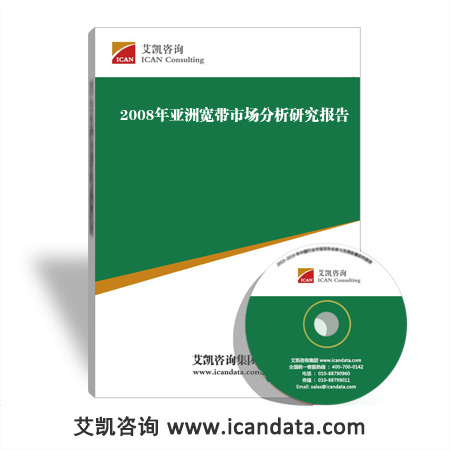数据来源与研究方法:
- 对行业内相关的专家、厂商、渠道商、业务(销售)人员及客户进行访谈,获取最新的一手市场资料;
- 艾凯咨询集团对长期监测采集的数据资料;
- 行业协会、国家统计局、海关总署、国家发改委、工商总局等政府部门和官方机构的数据与资料;
- 行业公开信息;
- 行业企业及上、下游企业的季报、年报和其它公开信息;
- 各类中英文期刊数据库、图书馆、科研院所、高等院校的文献资料;
- 行业资深专家公开发表的观点;
- 对行业的重要数据指标进行连续性对比,反映行业发展趋势;
- 通过专家咨询、小组讨论、桌面研究等方法对核心数据和观点进行反复论证。
报告简介:

摘要
This market report provides a comprehensive overview of the broadband Internet segment of the market across the various economies of Asia. Asia makes a strong claim to be leading the world when it comes to the development of broadband Internet. In fact, in 2008 after the mobile market, broadband is the fastest growing telecom market segment in Asia. The energetic expansion of broadband, however, has remained more of a phenomenon limited to the developed economies, with narrowband dial-up access being the norm in the poorer developing countries of the region.
Of course, there are signs that this is changing, but for the moment there is a ‘digital gap’. In those economies where the broadband market is taking off, DSL and cable modem platforms have both proved popular, with DSL having had a clear advantage. With DSL dominating the world market, Asia has become the leading market in the world for DSL, with about 38% of the world’s DSL subscribers. More recently, we have seen the advent of FttH as an alternative platform for broadband access. In the leading technology markets of Japan and South Korea FttH is starting to displace other forms of high-speed Internet access.
With broadband Internet continuing to take Asia by storm, the region’s broadband market finds itself dominated by six players. And these are predominantly the economies of North Asia. South Korea, Hong Kong, Singapore, Macau, Taiwan and Japan, for the moment at least, have left the rest of the region behind in terms of penetration and sophistication of their broadband services and infrastructure.
Of these leading countries, South Korea is the most remarkable example of the Asian broadband revolution, with a broadband subscriber penetration in mid-2008 greater than 31%, while more than 90% of households in the country have a high-speed broadband Internet connection.
目录及图表
Table of Contents
- 1. Afghanistan
- 1.1 Overview
- 1.1.1 Broadband statistics
- 1.1.1 Broadband statistics
- 1.2 Voice over Internet Protocol (VoIP)
- 1.1 Overview
- 2. Armenia
- 2.1 Overview
- 2.2 Wireless Internet
- 2.3 Armenian Datacom Company (ADC)
- 2.1 Overview
- 3. Azerbaijan
- 3.1 Overview
- 3.1.1 Broadband statistics
- 3.1.1 Broadband statistics
- 3.1 Overview
- 4. Bangladesh
- 4.1 Overview
- 4.1 Overview
- 5. Bhutan
- 5.1 Overview
- 5.1 Overview
- 6. Brunei Darussalam
- 6.1 Overview
- 6.1.1 Broadband statistics
- 6.1.1 Broadband statistics
- 6.1 Overview
- 7. Cambodia
- 7.1 Overview
- 7.2 MediaRing’s acquisition of AngkorNet
- 7.1 Overview
- 8. China
- 8.1 Overview
- 8.1.1 Broadband statistics
- 8.1.1 Broadband statistics
- 8.2 Broadband forecasts
- 8.3 Broadband networks
- 8.3.1 Overview
- 8.3.2 Cable modems
- 8.3.3 Digital Subscriber Line (DSL)
- 8.3.4 Fibre-to-the-Home (FttH)
- 8.3.5 Broadband over Powerline (BPL)
- 8.3.6 Wireless broadband
- 8.3.1 Overview
- 8.4 Major broadband service providers
- 8.4.1 China Telecom
- 8.4.2 China Netcom
- 8.4.3 China Tietong
- 8.4.4 Other broadband providers
- 8.4.1 China Telecom
- 8.1 Overview
- 9. Georgia
- 9.1 Overview
- 9.1.1 Broadband statistics
- 9.1.1 Broadband statistics
- 9.1 Overview
- 10. Hong Kong
- 10.1 Overview
- 10.2 Regulatory issues
- 10.2.1 Regulatory developments
- 10.2.1 Regulatory developments
- 10.3 Broadband statistics
- 10.4 Cable modems
- 10.5 Digital Subscriber Line (DSL)
- 10.6 Major broadband operators
- 10.6.1 i-Cable
- 10.6.2 Hong Kong Broadband Network Services (City Telecom - CTInets)
- 10.6.3 Pacific Century CyberWorks (PCCW)
- 10.6.4 HKNet
- 10.6.5 CPCNet Hong Kong (PSINet Hong Kong Ltd)
- 10.6.6 Pacific Internet
- 10.6.7 SmarTone Broadband Services
- 10.6.1 i-Cable
- 10.1 Overview
- 11. India
- 11.1 Overview
- 11.1.1 Broadband statistics
- 11.1.1 Broadband statistics
- 11.2 Market development
- 11.3 National Broadband Policy 2004
- 11.4 Personal computers
- 11.5 Cable modems
- 11.6 Digital Subscriber Line (DSL)
- 11.7 Wireless broadband
- 11.7.1 WiMAX
- 11.7.1 WiMAX
- 11.8 Satellite
- 11.8.1 DirecPC
- 11.8.2 Bharti Broadband Networks
- 11.8.3 Reliance broadband network
- 11.8.1 DirecPC
- 11.9 Other broadband networks
- 11.1 Overview
- 12. Indonesia
- 12.1 Overview
- 12.1.1 Broadband statistics
- 12.1.1 Broadband statistics
- 12.2 First Media
- 12.3 TelkomNet
- 12.4 Wireless broadband
- 12.4.1 WiMAX
- 12.4.2 Wireless Local Area Networks (WLANs)
- 12.4.3 Internet via satellite
- 12.4.1 WiMAX
- 12.1 Overview
- 13. Japan
- 13.1 Overview
- 13.1.1 Broadband statistics
- 13.1.2 Mega Consortium/Broadband Consortium Japan (BB Japan)
- 13.1.3 Impact of broadband on voice market
- 13.1.1 Broadband statistics
- 13.2 Cable modems
- 13.2.1 Market overview
- 13.2.2 Regulatory issues
- 13.2.1 Market overview
- 13.3 Digital Subscriber Line (DSL)
- 13.3.1 Market overview
- 13.3.2 Major DSL providers
- 13.3.1 Market overview
- 13.4 Fibre-to-the-Home (FttH)
- 13.4.1 Market overview
- 13.4.2 Major FttH players
- 13.4.1 Market overview
- 13.5 Broadband over powerline (BPL)/powerline communications (PLC)
- 13.6 Global LAN Ethernet
- 13.1 Overview
- 14. Kazakhstan
- 14.1 Overview
- 14.1.1 Broadband statistics
- 14.1.1 Broadband statistics
- 14.2 Broadband TV (IPTV)
- 14.1 Overview
- 15. Kyrgyzstan
- 15.1 Overview
- 15.1.1 Broadband statistics
- 15.1.1 Broadband statistics
- 15.1 Overview
- 16. Laos
- 16.1 Overview
- 16.1.1 Broadband statistics
- 16.1.1 Broadband statistics
- 16.1 Overview
- 17. Macau
- 17.1 Overview
- 17.1.1 Broadband statistics
- 17.1.1 Broadband statistics
- 17.1 Overview
- 18. Malaysia
- 18.1 Overview
- 18.1.1 Broadband statistics
- 18.1.1 Broadband statistics
- 18.2 Broadband infrastructure
- 18.3 Broadband Internet
- 18.4 Digital Subscriber Line (DSL)
- 18.5 Wireless broadband
- 18.5.1 WiMAX
- 18.5.2 Time dotCom
- 18.5.3 NasionCom
- 18.5.1 WiMAX
- 18.6 Broadband Powerline (BPL)
- 18.7 Internet via satellite
- 18.1 Overview
- 19. Maldives
- 19.1 Overview
- 19.1.1 Broadband statistics
- 19.1.1 Broadband statistics
- 19.2 Internet via satellite
- 19.1 Overview
- 20. Mongolia
- 20.1 Digital Subscriber Line (DSL)
- 20.1.1 Broadband statistics
- 20.1.1 Broadband statistics
- 20.2 Fibre-to-the-building (FttB) project
- 20.1 Digital Subscriber Line (DSL)
- 21. Myanmar
- 21.1 Overview
- 21.1.1 Broadband statistics
- 21.1.1 Broadband statistics
- 21.1 Overview
- 22. Nepal
- 22.1 Overview
- 22.1 Overview
- 23. Pakistan
- 23.1 Overview
- 23.1.1 Broadband statistics
- 23.1.1 Broadband statistics
- 23.2 Cable modems
- 23.3 Digital Subscriber Line (DSL)
- 23.4 Wireless broadband/WiMAX
- 23.5 Fibre-to-the-Home (FttH)
- 23.6 Internet via satellite
- 23.1 Overview
- 24. Philippines
- 24.1 Overview
- 24.1.1 Broadband statistics
- 24.1.1 Broadband statistics
- 24.2 Regulatory issues
- 24.3 National Broadband Network (NBN)
- 24.4 Cable modems
- 24.5 Digital Subscriber Line (DSL)
- 24.5.1 PLDT’s myDSL
- 24.5.2 BayanTel
- 24.5.3 GlobeNet
- 24.5.4 Bell Telecom’s I-Direct
- 24.5.1 PLDT’s myDSL
- 24.1 Overview
- 25. Singapore
- 25.1 Overview
- 25.1.1 Broadband statistics
- 25.1.1 Broadband statistics
- 25.2 Broadband Multimedia Network – Singapore One
- 25.2.1 Project overview
- 25.2.2 Project development
- 25.2.1 Project overview
- 25.3 Next Generation National Infocomm Infrastructure (Next Gen NII)
- 25.3.1 Planning phase
- 25.3.2 Proposal phase
- 25.3.1 Planning phase
- 25.4 Broadband service providers
- 25.5 Cable modems
- 25.6 Digital Subscriber Line (DSL)
- 25.7 Powerline broadband
- 25.8 Internet via satellite
- 25.9 IP-Virtual Private Network (IP-VPN)
- 25.10 Fibre-to-the-Home (FttH)
- 25.11 Wireless broadband
- 25.11.1 Allocation of wireless broadband spectrum
- 25.11.2 Local Multipoint Distribution Service (LMDS)
- 25.11.3 WiFi
- 25.11.4 The Wireless@SG initiative
- 25.11.5 Ultra-Wideband (UWB)
- 25.11.1 Allocation of wireless broadband spectrum
- 25.1 Overview
- 26. South Korea
- 26.1 Overview
- 26.1.1 Broadband statistics
- 26.1.1 Broadband statistics
- 26.2 Growth drivers
- 26.2.1 Housing situation
- 26.2.2 Price
- 26.2.3 Broadband content
- 26.2.4 Government support
- 26.2.1 Housing situation
- 26.3 Major broadband ISPs
- 26.3.1 Broadband ISP market leaders
- 26.3.2 KT/KorNet
- 26.3.3 Hanaro Telecom/HanaNet
- 26.3.4 Korea Thrunet
- 26.3.5 Dacom/BoraNet
- 26.3.6 Onse
- 26.3.1 Broadband ISP market leaders
- 26.4 Broadband services
- 26.4.1 Overview
- 26.4.2 Cable modem
- 26.4.3 Digital Subscriber Line (DSL)
- 26.4.4 Very high data rate DSL (VDSL)
- 26.4.5 Apartment LAN (A-LAN)
- 26.4.6 Fibre-to-the-Home (FttH)
- 26.4.7 Broadband over Powerline (BPL)/Powerline Communications (PLC)
- 26.4.8 Wireless broadband
- 26.4.1 Overview
- 26.1 Overview
- 27. Sri Lanka
- 27.1 Overview
- 27.1.1 Broadband statistics
- 27.1.2 School Net project
- 27.1.1 Broadband statistics
- 27.2 Digital Subscriber Line (DSL)
- 27.3 Wireless broadband
- 27.1 Overview
- 28. Taiwan
- 28.1 Overview
- 28.1.1 Broadband statistics
- 28.1.2 National Information Infrastructure project
- 28.1.3 Government initiatives for broadband
- 28.1.1 Broadband statistics
- 28.2 Digital Subscriber Line (DSL)
- 28.3 Cable modems
- 28.4 Wireless broadband
- 28.4.1 WiMAX
- 28.4.2 M-Taiwan project
- 28.4.1 WiMAX
- 28.5 Fibre-to-the-Home (FttH)
- 28.6 Video-on-Demand (VoD)
- 28.6.1 Broadband content market
- 28.6.1 Broadband content market
- 28.7 High-speed ISP services
- 28.7.1 GigaMedia
- 28.7.1 GigaMedia
- 28.1 Overview
- 29. Thailand
- 29.1 Overview
- 29.1.1 Broadband statistics
- 29.1.1 Broadband statistics
- 29.2 Digital Subscriber Line (DSL)
- 29.3 Cable modems
- 29.4 Internet via satellite
- 29.5 Wireless Internet
- 29.5.1 WiMAX
- 29.5.1 WiMAX
- 29.6 Major broadband operators
- 29.6.1 True
- 29.6.2 TOT
- 29.6.3 CAT
- 29.6.4 Advance Datanetwork Communications (ADC)
- 29.6.5 Triple T Broadband/TT&T
- 29.6.1 True
- 29.1 Overview
- 30. Uzbekistan
- 30.1 Overview
- 30.1.1 Broadband statistics
- 30.1.1 Broadband statistics
- 30.1 Overview
- 31. Vietnam
- 31.1 Overview
- 31.1.1 Broadband statistics
- 31.1.1 Broadband statistics
- 31.1 Overview
- 32. Glossary of Abbreviations
亚洲宽带
















